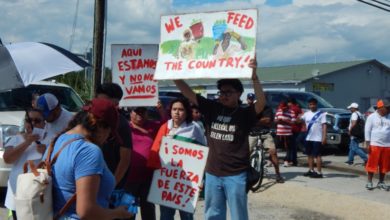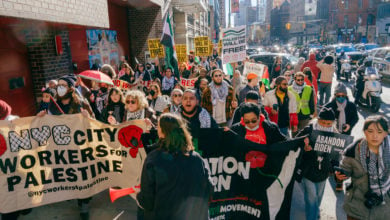Spring 2006 will be remembered for the huge mobilization of immigrant workers demanding their rights. This spring, the ruling class has opened up a new wave of terror against those communities, with an increase in brutal raids against immigrant communities across the United States.

From New Bedford, Mass., where 361 undocumented workers were rounded up in a leather factory on March 6 to be deported, to communities across California where almost 400 workers and their families were arrested in March and April, the cops and federal government are sowing fear in the mainly Latino immigrant communities.
Parents are keeping children home. People are staying away from work, hoping they will not be targeted by the feared agents of Immigration and Customs Enforcement.
“Operation Return to Sender,” the racist and sinister title of these massive raids, is meant for one purpose: to strike fear in the Latino and other immigrant communities, and to whip up a racist climate in the rest of the population. Most of the raids are deliberately aimed at people’s homes, creating more insecurity.
The intensifying U.S. raids are forcing many of the deported undocumented families to make devastating decisions: whether to leave their U.S.-born children in the United States or bring them to an uncertain future in their homeland.
The raids have shone a spotlight on the existence of detention camps where thousands of undocumented workers are being abused and detained for months.
One California family’s experience has laid bare the barbarity of the U.S. government’s anti-immigrant racism. On Feb. 28 in Palo Alto, Pedro Ramírez, a 38-year-old gardener originally from Mexico, was with his wife Isabel Aguirre at home, having just taken their four children to school. They were about to go to their respective jobs when ICE agents raided their home and immediately deported Ramírez. He had no time to say good-bye.
A monitor was placed on Aguirre’s ankle. She was ordered to prepare for deportation on April 5. For a little more than a month, the family endured the agonizing approach of the deadline.

Community, church and immigrants’ rights activists mobilized to defend the family and highlight the cruelty of the United States government’s policy of criminalizing workers and their families.
ICE officials told the media amid the growing public protest that the family had refused to respond to legal orders to appear at hearings. But Ramírez and Aguirre did not receive notices to appear at hearings; they received orders for deportation. As is typical, once families or individuals receive notice of the government’s intent to deport, many try to lay low and hope they can continue to live their lives in peace, while they struggle to survive.
Why would anyone present themselves for arrest and guaranteed deportation?
The fact that Ramírez had lived and worked in the United States for 22 years—since 1985—and his wife, a hotel maid, came in 1989, was of no consequence to the government. Their immigration petition for the right to become legalized was denied twice, once in 2002 and again in 2005.
Neither does it matter to ICE that all of Aguirre’s and Ramírez’s children are U.S.-born citizens and do not know their parents’ homeland. They do not speak any Spanish, and only understand a limited amount.
The U.S. government gave the parents an impossible choice: Leave your children to foster care in the United States while you are banned from U.S. entry for at least 10 years, or take your children with you to Mexico.
A press conference on the eve of Aguirre’s deportation brought together representatives of 32 Palo Alto-area churches, along with immigration attorneys and other community activists. They demanded a halt to the deportation and for a humane legalization reform.
The four children, Pedro, Yadira, Adrián and Adriana, 6 to 15 years old, were crying, fearful for their future. The trauma of being torn from one’s home, the shame and psychological suffering that is imposed on the children, is being repeated across the country as more doors are broken down and working-class families arrested.
Capital hit by crackdown
The enormous marches last spring and the historic May Day work boycott showed that undocumented workers are an indispensable part of the working class in the United States. Even before May 1, 2006, arrived, some of the largest meatpacking plants in the world and other companies that are heavily reliant on immigrant labor had to announce they would close for the day.
The huge agribusiness industry shut down entirely in California as the determination of immigrant workers to take part in the May Day 2006 boycott swept the great agricultural valleys of the state.
But in the midst of the protests, the Department of Homeland Security announced that mass raids would begin, targeting workplaces across the country. They have continued to this day.
Some industries have been disrupted by Homeland Security’s targeting of factories. In December 2006, 1,282 undocumented workers were arrested at six Swift beef and pork processing plants.
Agribusiness has also been hit hard. The 2006 avocado harvest was devastated—not by weather conditions but by the lack of immigrant workers to pick the crops. Because of the repressive measures adopted by the U.S. government along the U.S.-Mexico border and the “Wall of Death,” thousands of undocumented workers from Mexico who seasonally travel to the United States for the harvest were blocked from entering. Growers had only about 50 percent of the workforce they normally depend on.
Fully 95 percent of all U.S. avocados are grown in San Diego County. Avocado agribusiness was short tens of thousands of workers for the harvest. The workers undoubtedly were left with little or no means of economic sustenance at home.
According to the California Rural Legal Assistance, 97 percent of all California agricultural workers are Mexican and over half are undocumented.
Behind the raids
Why are the raids and deportations taking place despite the importance of millions of immigrant workers for strategic sectors of the capitalist class? Why would a sector of the capitalist government endanger the profits of the very class it represents by attacking so viciously the workers it depends on?
Some elements of the ruling class undoubtedly fear the impact of the immigrant population’s presence in the United States. With the large influx of immigrants, primarily from Latin America but from every part of the world as well, the U.S. working class in recent years has become much more diverse. The changed demographics have an impact not just in numbers but also in the working class’s consciousness and its potential for struggle.
The Latino community is large and significant in California, Arizona and the Southwest, in New York and the Northeast and throughout the South.
The aim of racist attacks on immigrants, particularly on Latinos, was shown most clearly in 1994 with Proposition 187 in California. California’s biggest industry is agribusiness. Yet, racist politicians and big business, led by then-governor Pete Wilson, organized a virulently racist television campaign depicting Mexican and other immigrants invading the state, blaming them for the economic problems at the time.
Proposition 187 would have banned public school K-12 education for undocumented children as well as medical care for anyone who did not have legal residency. The backers of Proposition 187 knew that the millions of undocumented workers in California would have remained in the state—but under much more exploitative conditions.
Today’s racists are cut from the same cloth as the backers of Proposition 187. The whole racist lot, from politicians like Rep. James Sensenbrenner to media personalities like Lou Dobbs to fascist gangs like the Minutemen to Bush administration officials—acting on behalf of the capitalist rulers behind them—denounces the undocumented workers for their “illegality” while providing absolutely no means for their legalization.
Homeland Security head Michael Chertoff proclaimed last year at the height of the pro-immigrant mobilizations that millions would be deported over time.
Divide and conquer
Of course, no sector of the ruling class really wants to eliminate all immigrants—the source of so much profit. More than reducing the number of immigrant workers, the anti-immigrant campaign is aimed at driving immigrant workers into submission, to accept their exploitation without a fight. The climate of fear in the long run can translate into lower wages and fewer benefits for millions.
By blaming high unemployment and economic difficulties on immigrants, the campaign aims to divert the growing working-class anger away from the ruling class and toward immigrant workers. A divided working class in the United States is one that can be manipulated and more effectively oppressed.
That was the real aim of the extremely repressive Sensenbrenner House bill 4437 in 2005 and 2006. If approved and signed into law, it would have immediately classified all undocumented workers—estimated at 12 million people—as felons. Any institution or individual assisting the undocumented would be liable as criminals as well.
This project has spawned other reactionary legislation in cities, towns and states against immigrants, banning employment and housing rentals by the very towns and cities that depend on their labor.
The fear and anger in the immigrant community across the United States over the possibility of mass roundups and criminalization that was built into “Sensenbrenner” became fuel for the fire of resistance. Millions of undocumented workers, their families and pro-immigrant supporters marched en masse.
Millions of immigrant workers demanded not only an end to the repression but equal rights and amnesty. It was a bold development that signaled the great political potential of this awakened sector of the working class, the idea that in the midst of repression they would demand their equal rights as workers, even when the odds seem stacked against them.
‘Sí se puede’
From the first march against Sensenbrenner on March 10, 2006, in Chicago—which drew a surprising 300,000 people—to the million-plus in Los Angeles on March 25, to the millions who filled the streets from coast to coast on May Day, the proud and defiant mobilizations of the undocumented and legal resident immigrants made history. The cry of “Sí, se puede”—we can do it—was heard from coast to coast.
On that historic May Day 2006, the immigrant workers, without any legal rights or guarantees, displayed their power and consciousness as workers, the power to stop the system’s machinery and the consciousness to demand equality.
No one should forget or overlook the significance of the 2006 mobilizations, especially as some in the labor movement and the more moderate wing of the immigrant-rights movement urge a wait-and-see attitude and quiet lobbying approach while they hope for Congress to enact legislation. It is their concern not to be “too demanding” of the Democratic Party in the 2008 elections that guides their caution.
These days are full of dread, uncertainty and suffering for millions of workers who simply want to work and live in peace, to be able to support their families back home and make a future for their children.
What will be key in the months to come is for the more politically conscious elements in organized labor, for the progressive and the anti-war movement, to unite with the immigrant working-class, and declare to all that an injury to one is an injury to all.
The unity of the growing anti-war movement and the immigrant movement in struggle can give both the strength to resist U.S. imperialism’s war at home and abroad, and provide real direction for the working class of the United States
Los Angeles, April 7
Photo: Travis Wilkerson
The government has stepped up raids and deportations to terrorize undocumented workers.
Photo: Reuters/Bret Hartman






